Development of a Jet Drive for Small
Boats
using a Commercial Water Pump - Part 2
by Steve
Hansen
Back to Part
1
Water Trial 1
The photo below shows the jet pump
and its accessories installed in Candy's 12 foot tin skiff. I
was hoping that the Evinrude could be used for comparison and
backup but I was informed that it hadn't worked all summer. The
oars did work.
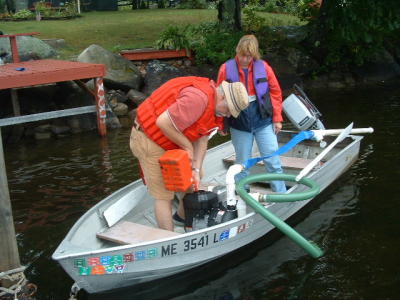
Please note the piece of green suction
hose hanging over the side. This was to prove problematic.
After rowing
out into the pond a bit we fired up the engine. The bloody thing
actually worked. At something just above idle with about 10 psi
at the nozzle we were moving at about 1.5-1.7 mph as measured
by GPS. Going to full throttle we accelerated to around 5 mph
(30 psi on the gauge) but couldn't go in much of anything resembling
a straight line. A big problem was posed by the 9 ft. length of
suction hose which didn't really want to stay underwater and was
causing quite a bit of drag. Nonetheless it worked.
Two exciting action shots are shown
below.
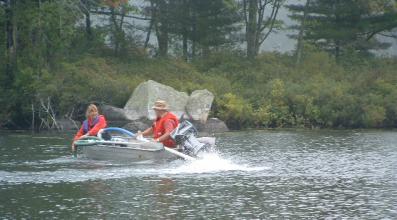
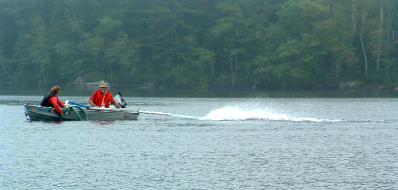
Disaster strikes!
The welded pvc fitting just above the pump outlet gave way producing
a rather impressive geyser. Henceforth we called the jet drive
"Geyser King." Notice how Candy got the worst of it.
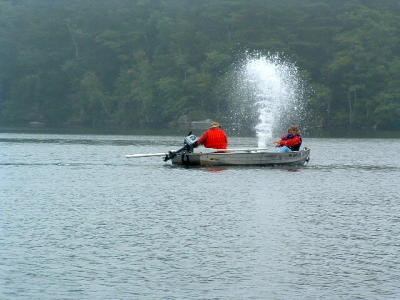
Nothing damaged but we were a bit
wet upon return to the dock.
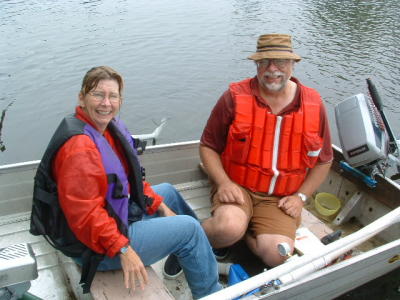
Here is the offending fitting. Candy
is pointing out my flawed plumbing technique. Amid a few epithets
she said something about needing threads.
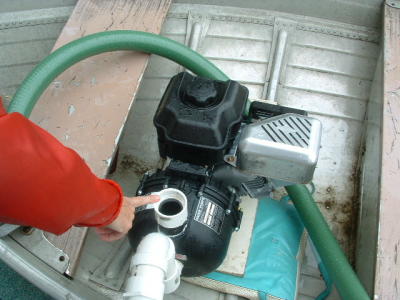
Water Trial 2
Time for lunch and to make some
repairs. I was mystified as to why the fitting let go but I cleaned
it up and applied more solvent and glue and let it set while we
had lunch.
Another item to take care of was
the pesky suction tube. Ideally we'd have a flush through-hull
fitting with strainer but Candy had something against putting
holes in her boat. So we elected to try to constrain the hose
as much as possible to the side of the boat. A couple of rope-and-clamp
schemes failed so we elected to duct tape a brick to the hose.
Ever resourceful, Candy had a roll of 6" wide duct tape (eat your
heart out Red-Green!).
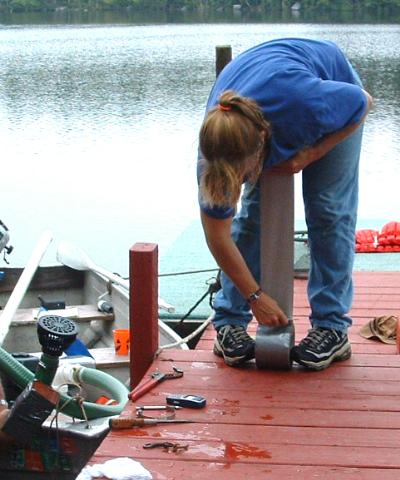
The photo below shows the fully
dressed and weighted suction hose.

Time for the next test.
Under way again
the suction tube was still making a lot of drag (it wasn't possible
to row the boat much faster than 1.5 mph) but with the tube closer
to the boat, directional control was much improved and we were
actually able to go in straight lines and make predictable turns.
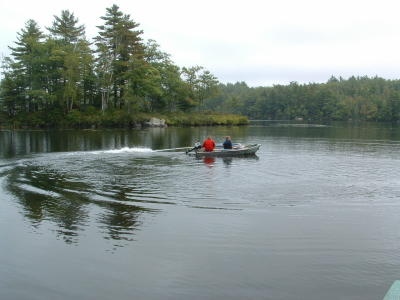
For those who think that the nozzle
would work better immersed the answer is absolutely not. Immersion
caused cavitation and a reduction of the top speed to around 3.5-4
mph. And it doesn't look near as impressive.
Just as we were
getting comfortable with the thing, the second disaster. The same
fitting let go. This time Candy had a hard time reaching the throttle
and we both got even more thoroughly drenched. Notice how you
can't see Candy.
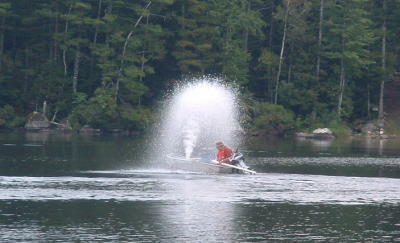
From the shore all that could be
heard was crazy laughter and shouts of "kill the throttle, kill
the throttle."
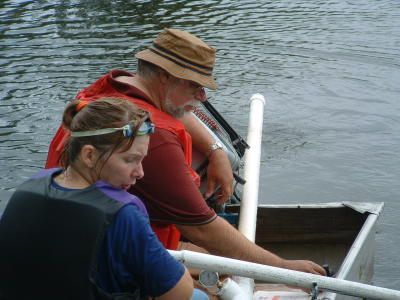
Please note the swim goggles on Candy.
Of course, she wasn't wearing them when the pump let go.
Enough for today, we figured another
attempt at repair would be futile. Time for dry clothes, beer
and wine.
Summary and Next Steps
First, in case you wonder where my
wife Chris was, she was playing the part of the smart older sister,
staying dockside and taking the pictures. No dummy she.
I think that this was pretty successful,
enough to warrant outfitting a boat properly for this simple jet
pump. I've already figured out how to adapt it to my stalled Shell
Swifty-14 rebuild project in a way that won't damage the boat
should I eventually abandon the project.
Some tentative conclusions:
- In my backyard test setup I was able to
achieve about 40 psi pressure with the 24mm nozzle. In the
boat I was only able to obtain about 30 psi. This may be due
to the longish suction hose as compared with the backyard
suction tube which may have acted to limit the capacity of
the pump.
- The nominal top speed was largely due,
I believe, to the hull speed of the boat and the drag of the
suction tube. When rowing the tube and brick did have a noticeable
drag. A longer, cleaner hull should do better.
- It's certainly been a fun project thus
far!
I plan to have the Swifty outfitted
with the jet drive by the spring of 2004. Stay tuned.

Back to Part 1
Visit Steve
Hansen's Boat Page

|

